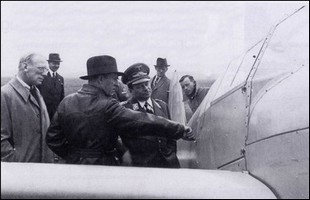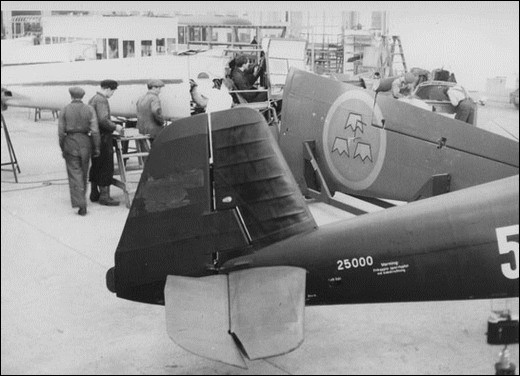 |
Bücker Bü 181 Bestmann
When the Bücker Bestmann came into service in 1941 it quickly became a very popular trainer. The reason for this was that instructor and student flew sitting side-by-side and not in tandem, which had been customary before. This had obvious advantages; you could see the actions of the other, instead of trying to make your point shouting down a tube.
[ Top of page ]
History
Bücker Bestmann was conceived as a general sports plane. Since it entered the stage in the late 1930's however, it made its career mainly as a military trainer. It was designed by Swede Anders Johan Andersson, who at the time was working for Bücker Flugzeugbau GmbH in Berlin. He was later employed by Saab where he worked on Saab 18 and Saab 91 Safir. The Bestmann and Safir have a striking resemblance.
Bü 181 was constructed in a steel tube and wood combination, covered with veneer and canvas. The powerplant was a Hirth 105 hp four-cylinder engine. Later versions were fitted with a more powerful engine. And, for the first time, instructor and student were seated shoulder-to-shoulder.
 |
Testing of the prototype with Bücker's chief pilot Arthur Benitz at the controls. |
| Designer A J Andersson demonstrating a detail to Generaloberst Ernst Udet, head of the technical branch at RLM. On the far left is C C Bücker. |  |
The prototype D-ERBV flew for the first time in February 1939, and after intense testing by the RLM - Reichsluftfahrtministerium - the Bü 181 was appointed new standard trainer for the Luftwaffe. Most of the aircraft built came from the Bücker plant at Rangsdorf, but as production rates increased, another 373 were licensed to be built by Fokker in Holland and were delivered to the Luftwaffe by the end of 1943.
The Bestmann was also to be built under license in Sweden. One Bü 181B was bought from Germany in June 1942 to stand model if manufacturing was to start, and negotiations with Bücker were initiated.
 |
| Hägglund & Söner's aircraft factory in Örnsköldsvik, where Bücker Bestmann was manufactured under license. Many of the workers had been retrained for building the Bestmann through a collaboration with Hermods distance education in Malmö. In the foreground is the original German Bü 181B that was used as a model. This and the top picture are from the SFF archive. |
Carl Clemens Bücker was no stranger to Sweden. In the early 1920's he started a company called Svenska Aero in Stockholm. The idea was to assemble aircraft from - in the beginning mostly smuggled out of Germany - pre made parts. When bussiness turned bad the company was sold to ASJA, that later became Saab. Because Bücker considered himself the victim of unfair treatment at the time of the takeover, he ten years later objected to giving Saab the license to manufacture the Bestmann. Instead, Hägglund & Söner in Örnsköldsvik got the contract for 120 aircraft. They were built between 1943 and 1946 and delivered to F 5, the Swedish air force's flying school at Ljungbyhed. Their military designation was Sk 25 and the Bestmann served in the air force for a decade, 1944-1954.
After World War Two the Bücker Bestmann served in many air forces and flying clubs around the world. In Egypt, it was used for basic flight training as late as in the late 1990's!
[ Top of page ]
Video
| This video starts off with close studies of the aircraft in a hangar, with suitable music, followed by an air display somewhere in England, this time without music. If instant action is preferred, skip the first two minutes. |
|
[ Top of page ]